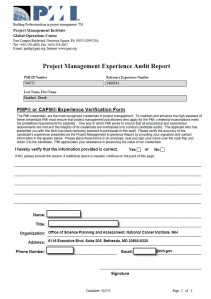An interesting thing happened when I was approached by a coworker asking for assistance in completing his PMP application. His concern was he would be audited and word around the office was that I had been audited by PMI and did just fine. Both facts were true and I was more than happy to assure him that as long as he was factual about what he put in this application, he would have nothing to worry about. All the same, he said he would feel more comfortable if I would review what he wrote. He admitted that what he was going to show me wasn't his actual application, but rather, he was working on a spreadsheet to make sure he had his bases covered. Good idea, I said, show me what you have. What he brought up was an Excel workbook, provided by another coworker who had recently attended a PMP boot camp. I noticed right away that he had 7 projects listed totaling over 10,000 hours. What really caught my attention was the breakdown of hours across the process groups. Below is an example of one of the projects. Names and titles have been changed but the hours were not.
Company
Project Title
Job Title
Start - End
Total Hrs
Initiate
Plan
Execute
Control
Close
Acme
Foo
Sr. PM
11/04 11/05
2000
100
500
1000
300
100
I asked him how he came to such exact amounts per process group. He pointed to help text listed in the bootcamp-provided workbook.
In the following worksheet, we will try to compile the hours you spent on each Process Group for each of your project. Eventually, you will need these hours to fill in the PMP Application... Let us assume that this is the typical project manager job with about 85% of the hours involving tasks similar to those in the Typical PM Task worksheet. Assuming this was a typical project manager task with a rough distribution of 5% of these hours in Initiation, 25% of hours in Planning, 50% of hours in Executing, 15% of hours in Controlling, and the remaining 5% in Closing.
When I asked him to explain what I was seeing, he stated he had worked on the project for a year and took a 2 week vacation. (2,000 hours). Then he said something that surprised me. Well, the worksheet said to put percentages in so that's what I'm doing. My response was "Noooooo, that's for a "typical" PM doing "typical" PM tasks. I told him was listed in the help text was a calculated average and only there as a guideline. In addition, I clarified, I didn't think he could map 100% of his time to deliverables.
I told him that he needs to look at mapping his work experience to the process groups like he would if he were identifying and scheduling activities of any project. (Reference the PMBOK for items in blue)
Define Scope (Section 5.2 - Page 112)
Create Work Breakdown Structure (WBS) (Section 5.3 - Page 116)
Define Activities (Section 6.1 - Page 133)
Sequence Activities (Section 6.2 Page 136)
Estimate Activity Durations (Section 6.4 - Page 146)
Now, you may disagree with what I proposed but I hope you understand my frustration after seeing something like this. First, he didn't read the instructions correctly. Second, his primary concern was being audited, not meeting the fundamental requirement of detailing work activities. This brings me to my final point. Before defining scope, you need to collect requirements(Section 5.1 - Page 105).
I've come to find out, he doesn't even want to get the PMP. He's being pressured by his company to get the certification. The whole situation could be fodder to half a dozen posts or articles. I don't know what part bothers me more, that he missed the assumptions listed by the PMP boot camp or the fact that his company is pressuring him to get a certification that he doesn't want.
I wish him luck.










